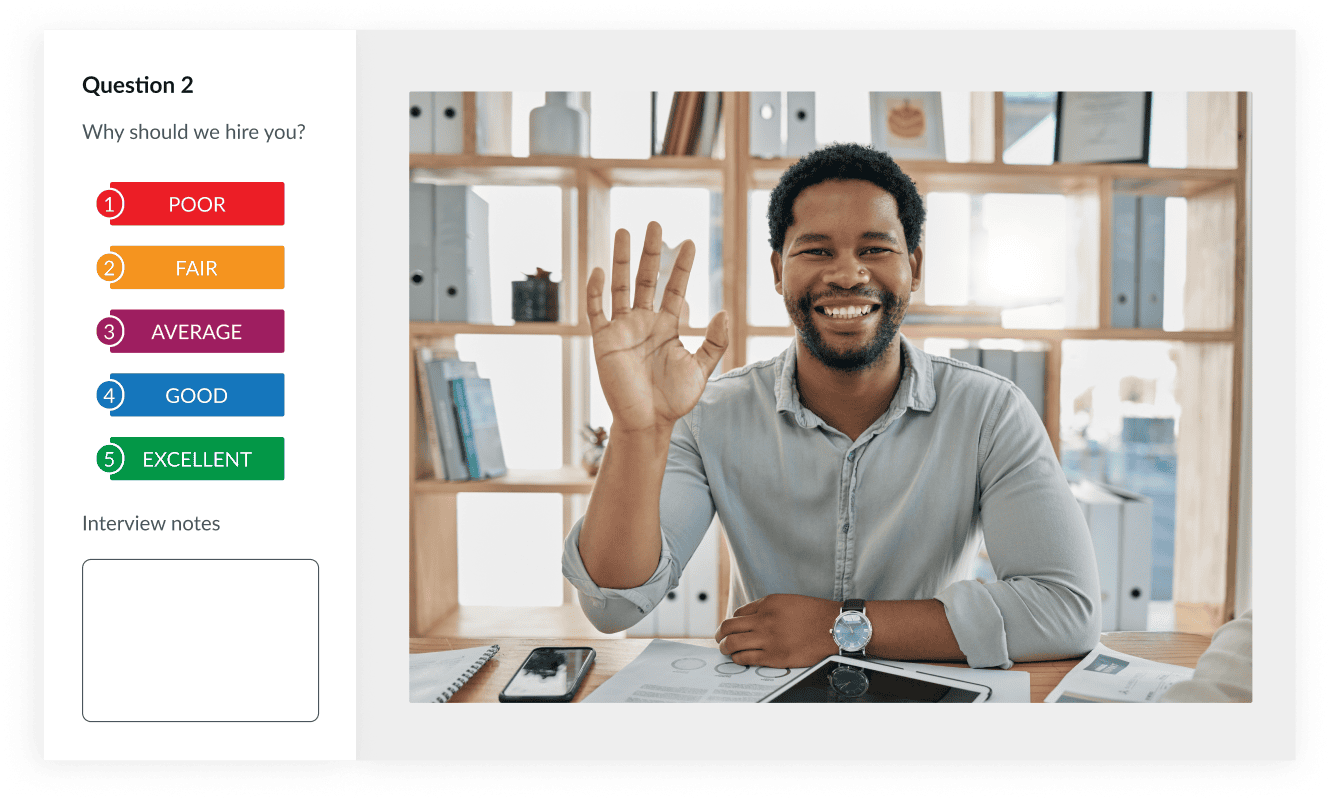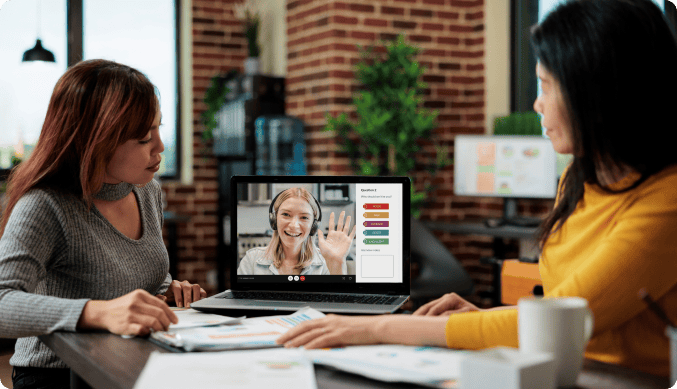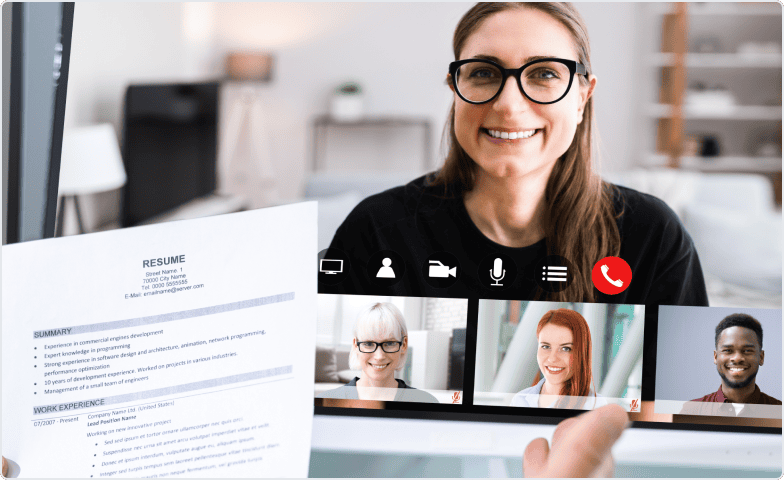Mastering the Art of the Digital Interview
Written by
Kim JamersonAbout the Author
Kim is an experienced, award-winning journalist and marketer with expertise in B2B Saas, Human Resources, and cyber security.
Reviewed by
VidCruiter Editorial TeamAbout the Author
The VidCruiter Editorial Team offers practical recruitment advice, drawing on insights from seasoned professionals. Our award-winning content, supported by industry specialists, underscores VidCruiter's dedication to innovation in recruitment.
Last Modified
May 8, 2024
Digital interviews have become the norm in most companies’ hiring processes. In fact, according to Indeed, 82% of employers have incorporated them in their hiring process.
Of course, usage varies across industries and job types (in-person vs. remote). But, given the prevalence of digital interviews, chances are you will be asked to participate in one, either as a candidate or as part of a hiring team.
Read on to learn about the format and top tips to master the art of the digital interview.
What is a Digital Interview?
Digital interviews (a.k.a. virtual interviews) are conducted online using purpose-built or video-conferencing tools. Companies often use them in their hiring process to give them the flexibility to attract and evaluate top talent regardless of location. Digital interviews also facilitate enhanced data collection, record keeping, and process efficiencies, contributing to a more streamlined and data-rich recruitment program. They come in two varieties, live and pre-recorded:
- Live: The interviewer or interview panel “meets” with the candidate virtually, interacting with each other in real time. Both the employer and the candidate can ask and answer questions. There are also in-person variations of this interview.
- Pre-recorded: The employer sends a preset series of questions, and candidates record on-camera answers independently. The recruiter or hiring team reviews these responses later, hence these are also called asynchronous or one-way interviews.
What is an in-person digital interview?
A digital in-person interview closely resembles a traditional interview where candidates meet the interviewers face-to-face but with the interview ratings and notes captured in a digital interview platform. This approach not only ensures a consistent evaluation process across both in-person and video interviews but also creates a permanent record of the interactions. It facilitates a structured interview process, allowing for fair and direct comparisons among candidates.

Benefits of Digital Interviews
Digital interviews offer many benefits compared to their traditional, on-site counterparts – both for employers and candidates. The most obvious one is that they can be conducted anywhere that participants have access to the internet.
For employers, this broadens the pool of candidates and removes travel or accessibility barriers and other geographic constraints. It also opens the doors to having a more diverse hiring committee consisting of employees in disparate locations. Applicants gain the added benefits of completing the interview from the comfort of their homes (or wherever they choose) and avoiding the stress of getting to the interview on time.
Pre-recorded interviews, which are often used in early screening stages, offer additional advantages:
- Structured Interview: All candidates answer an identical set of interview questions and have the same time and opportunity for their responses.
- Flexibility in Scheduling: Instead of struggling to find a time that works for everyone involved, candidates get to record their responses at their convenience, and evaluators watch the videos later when their schedules permit.
- Diversified Review Panel: Initial screenings are typically completed over the phone by recruiters who pass on notes and recommendations to the hiring manager to determine if a candidate moves forward. Pre-recorded interviews create opportunities for more people to be involved in the initial review.
- Objective Evaluation: The combination of every candidate answering the same questions and every evaluator seeing the same responses vs. relying on third-party notes reduces the likelihood of bias affecting the hiring process. Using interview scorecards, which allow each interviewer to rate candidate responses to individual questions, provides an additional layer of transparency and ensures a more equitable hiring process.
- Transparent Reporting: Evaluators rate candidates’ responses to each question individually, which makes it easier to see a comprehensive view of each candidate’s strengths and weaknesses and to compare applicants and identify top talent. Additionally, maintaining these records for an appropriate period helps ensure a defensible position in hiring decisions, supporting compliance and accountability in the recruitment process.
- Continuous Improvement: Digitizing interviews enables organizations to track key variables such as interview scheduling details, the number and type of questions, interviewer performance, and specific candidate responses to improve recruitment. By analyzing this data, organizations can refine their recruitment, identify essential job criteria, and enhance interview strategies to better predict a candidate’s potential job performance.
All of these factors add up to a recruiting process that’s more efficient, accessible, and inclusive. Great for candidates and employers alike.
Artificial Intelligence (AI) and digital interviews
Recently, many companies have incorporated AI into their recruitment process, from resume reviews to video interview assessments. Not all digital interviews utilize AI but some do. Those platforms evaluate candidates by assessing their responses- some include additional criteria like body language, word choice, and tone of voice- to determine their suitability for the role.
Potential advantages: Making recruitment faster and more efficient with the possibility of reducing bias. AI assessment tools are programmed to focus on qualifications and avoid human preconceptions.
Potential risks and concerns: AI tools may inadvertently perpetuate or introduce bias. They could lead you to breach anti-discrimination laws since the tools learn from preexisting data, which may contain inherent biases, rather than formulating independent thought. AI evaluations may also be inconsistent or opaque, sometimes based on criteria completely irrelevant to the job. There are also legal considerations around areas like data security and privacy, as well as ethical considerations and candidate transparency.
Best practices for AI in recruitment are evolving, but with 88% of companies globally already using some form of AI in HR (SHRM), it’s a trend that appears to be here to stay.
How to Prepare for a Digital Interview
When it comes to digital interviews, the short answer is to prepare exactly how you would an on-site interview. While video interviewing may feel more casual because interviews can take place at home, candidates should approach them with the same level of planning and professionalism they would for traditional interviews…and then some.
Check out these video interview tips for detailed guidance about how to ace a digital interview, but here are a few key considerations.

Pre-Recorded Digital Interviews
While there are a lot of similarities between live and pre-recorded digital interviews, the latter is a newer approach that many job seekers haven’t encountered before. So before diving into tips that apply to all digital interviews, here’s an overview of what to expect:
- Invitation: Candidates receive an invitation to complete the asynchronous video interview by a specific date. This invitation usually includes instructions on how to access the interview platform and complete the process.
- Question Prompts: Candidates are presented with a series of preset questions in written or video format and are given time to read or watch the material before responding.
- Recorded Responses: Candidates are allotted a brief amount of time to answer the questions (typically one to two minutes each). Depending on the employer's platform and setting preferences, candidates may see a countdown to when the recording will start and another clock showing how much time they have left to complete answers for each question. In some cases, candidates can re-record responses. In others, candidates only get one take. Before beginning, be sure to review the instructions provided in the invitation email and ask clarifying questions.
- Submission: Candidates submit completed interviews after recording answers to all of the questions.
- Review: The hiring team, including recruiters, hiring managers, and other stakeholders, reviews the video responses and submits evaluations.
- Follow-up: Most platforms provide an automated confirmation after submitting the interview and provide an estimated timeframe for decisions. Once evaluations are completed, employers will let candidates know if they’re proceeding to the next step.
In some cases, once the pre-recorded session starts, there may be very little flexibility, so take extra care in preparing for this format.
Digital Interview Questions
The reality is that questions asked during digital interviews, live and pre-recorded, mirror questions asked during on-site interviews. That’s because regardless of format or location, employers are fundamentally trying to assess a candidate’s skills, experience, personality, and cultural fit.

The exact questions will vary based on the stage (initial screening vs. final round), the interviewer (recruiter, hiring manager, colleague, senior leader), and the employer’s approach to hiring. But some of the most common digital interview questions include:
- Tell me about yourself.
- Why are you interested in this job?
- What are your biggest strengths/weaknesses?
- What do you know about our company?
- Where do you see yourself in five years?
- What makes you the best fit for this role?
- Tell me about a time you faced XYZ challenge and how you overcame it.
Be prepared to give brief and compelling answers to these questions. Include specific examples of success, overcoming adversity, and meeting or beating goals.
Write these stories down, and practice delivering them succinctly and with enthusiasm. It may sound silly, but this additional preparation will help you eliminate nervousness and go into the interview with confidence.
Technical Setup and Testing
Before heading into any digital interview, take the time to ensure that the software and equipment needed are available and working. If possible, test them days in advance and again 30 minutes before the interview.

Here are a few tech tips:
- Software: Video interview software varies in whether it requires users to download applications or is browser-based. Regardless, almost all of them need some configuration and possibly a reboot to work correctly. Take note of which platform the hiring company uses and ensure the device you intend to use is compatible and has the latest updates and permission settings set correctly. Most, if not all, of these tools allow you to test functionality ahead of your interview.
- Equipment: Make sure all devices are fully charged and are working together (e.g., Bluetooth connections are in place, audio levels are good, the camera is functioning and the lens is clean). Reboot your computer several hours before to allow new updates to be installed and avoid quirky issues with caching and cookies.
Taking time to test known variables will eliminate unnecessary stress heading into digital interviews. Still, technological snafus happen even with the best preparation, so don’t get rattled if they arise.
Setting and Attire
What to wear in digital interviews is a fairly easy question to answer. Make sure to dress professionally. That doesn’t mean you need to suit up for every interview. In fact, depending on the company culture or the role, wearing a suit might backfire.
But even for the most casual of companies, it’s always a good approach to present a well-groomed, professional look (i.e., no t-shirts or tank tops). Also, avoid busy prints and bright colors. They typically don’t translate well on webcams.

When it comes to setting, the most important consideration is finding a place void of distractions. You want to be focused on the questions, delivering great answers, and building rapport. Pick a location that’s quiet, and turn off or mute devices and messaging applications. Make sure family and roommates are aware of the interview and don’t disturb you. Lock pets in a different room or have someone keep them occupied.
Two other things to consider are lighting and background. Avoid placing windows behind you because you’ll be backlit and look like someone in a witness protection program. Instead, opt for lighting sources in front or above you.
Make sure your background is clutter-free and professional (e.g., no piles of laundry or tables in disarray). You can certainly show something that reflects a bit of your personality or interests but not in a distracting way.
Regardless, test your camera view beforehand, make adjustments, and if all else fails, go with a virtual background.
Wrapping Up
Remember that all the suggestions above are meant to prepare you for what to expect, reduce your apprehension, and allow you to shine in digital interviews. However, the most important rule with any type of interview is to relax and just be yourself.
Best of luck as you work to land your next role!

Frequently Asked Questions
How long do digital interviews last?
The length of digital interviews depends on many factors, including the type of position, the stage of the interview process, and employer preferences. Generally, they last anywhere from 20 minutes to an hour. Pre-recorded interviews typically include five to 10 questions, with a few minutes to respond.
Can I re-record responses for a digital interview?
Based on the platform used and employer preferences, candidates may be able to re-record answers, but in many cases, you will only get one take. Read the instructions in the invitation email to know your options before getting started.
What happens after a digital interview?
After you submit a pre-recorded interview, you should receive an automatic confirmation email that will often provide insights into what will happen next and how soon you should hear back from the employer. During live interviews, feel free to ask about the next steps at the end of the interview. Also, sending a follow-up email thanking interviewers for their time, reinforcing your interest in the position, and explaining why you’re a good fit is a nice touch.
Related Topics
Modernize your hiring process with expert insights and advice.



